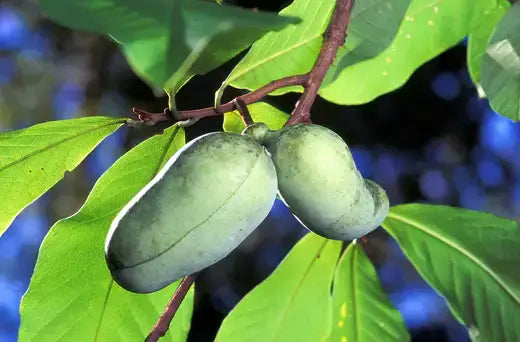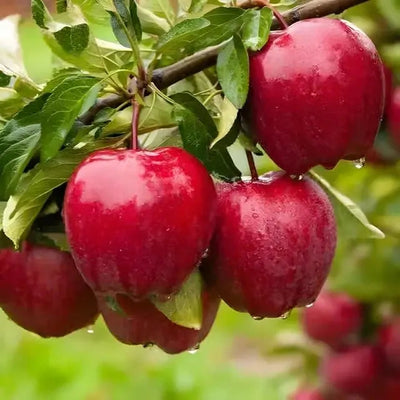The Paw Paw tree, scientifically known as Asimina triloba, is a unique and fascinating native tree often overlooked in favor of more common fruit trees.
With its tropical-looking leaves and deliciously sweet fruit, the Paw Paw tree offers a distinctive charm and a touch of the exotic to gardens and landscapes. If you're intrigued by this lesser-known tree, here's a comprehensive guide that provides essential information about Paw Paw tree planting, care, and cultivation.
Native Beauty: The Paw Paw tree is unequivocally indigenous to the eastern regions of the United States and certain parts of Canada. This plant thrives for hardiness in areas with moderate climates, specifically in zones 5 through 8. This plant thrives for hardiness in regions with average temperatures, specifically in zones 5 through 8. This tree is often found in forests and along riverbanks, making it a natural fit for landscapes with similar conditions.
Growth Habit: Paw Paw trees are small to medium-sized deciduous trees that typically reach heights of 15 to 30 feet. They have a unique growth habit, with large, drooping leaves that create a tropical feel in regions where such foliage is uncommon.
Sunlight and Soil Requirements: Pawpaw trees can grow in partial or full sun but tolerate more shade than other fruit trees. Pawpaw trees can grow in partial shade or full sun but tolerate more shade than other fruit trees. Pawpaw trees are well-suited for various growing conditions, including partial shade and full sun. It's worth noting that these trees can tolerate more shade than other fruit trees, making them an excellent option for gardens or landscapes with limited sunlight.
Pawpaw trees are well-suited for various growing conditions, including partial shade and full sun. It's worth noting that these trees can tolerate more shade than other fruit trees, making them an excellent option for gardens or landscapes with limited sunlight.
They thrive in well-draining, loamy soils that are rich in organic matter. Soil pH should be pH 5.5 to 7.0. Pollination and Fruit Set: Unlike many fruit trees, Paw Paw trees have an exciting pollination process. They rely on carrion flies and beetles for pollination, emitting a foul smell similar to rotting meat to attract these insects. For successful fruit production, planting multiple Paw Paw trees to enhance cross-pollination is often recommended.
Fruit Development: The Paw Paw tree's fruit is the show's star. The fruit resembles a sizeable green mango or custard apple, with a custard-like texture and a sweet, tropical flavor. The skin can be easily bruised, so handle the fruit with care.
As the fruit ripens, its color changes from green to yellowish. Cultivar Selection: When choosing Paw Paw trees for planting, consider selecting cultivars adapted to your climate and soil conditions. Different cultivars may vary in fruit size, flavor, and cold hardiness.
Popular Paw Paw cultivars include 'Sunflower,' 'Overleese,' and 'Mango.' Planting Time: The best time to plant Paw Paw trees is in the early spring or late fall when the weather is more relaxed, and the trees are dormant. Establishing its root system before facing the stress of hot summer temperatures is crucial for the tree's survival and ability to thrive in the future.
Establishing its root system before meeting the stress of hot summer temperatures is essential for the tree's survival and ability to succeed in the future. Planting Process: For optimal growth of your Paw Paw tree, it's recommended to dig a hole twice the width of the root ball and at the same depth.
Happy planting! Place the tree firmly into the hole, ensuring the root ball's top is level with the ground. Place the tree firmly into the hole, ensuring the root ball's top is level with the environment. Make sure that the soil is packed into the hole and given a thorough watering, being mindful to avoid any pockets of air. This will help to prepare the area for future growth and ensure healthy plants.
Spacing Considerations: Paw Paw trees should be spaced approximately 10 to 20 feet apart, depending on the expected mature size of the variety. Proper spacing ensures adequate air circulation and sunlight for healthy growth.
Mulching Benefits: We highly recommend applying a layer of fantastic organic mulch around the base of the majestic Paw Paw tree. Not only will it retain soil moisture, but it will also regulate temperature and suppress pesky weed growth. Keep the mulch a few inches from the trunk to prevent moisture-related issues.
Watering Routine: During the first growing season, provide consistent watering to help the young Paw Paw tree establish its root system. Once installed, Paw Paw trees are relatively drought-tolerant, but regular watering during dry spells promotes healthier fruit production.
Pruning Practices: Paw Paw trees typically have a natural, somewhat bushy growth habit. We highly recommend lighting pruning on your tree to eliminate dead or diseased branches while promoting better air flow and sunlight exposure.
Disease and Pest Management: While relatively low-maintenance, Paw Paw trees can be susceptible to certain pests and diseases. Common issues include fungal diseases such as leaf spots and fruit black spots. Regularly inspect your trees for signs of infection and address any problems promptly.
Fertilization Strategy: Paw Paw trees benefit from a balanced, slow-release fertilizer applied in early spring before new growth emerges. It is imperative to steer clear of excessive nitrogen, as it can result in an overgrowth of foliage to the detriment of fruit production.
Protecting Young Trees: Young Paw Paw trees are particularly vulnerable to deer browsing. Consider using tree guards or other protective measures to prevent deer from damaging young plants.
Winter Protection: Winter protection can benefit young Paw Paw trees in colder climates. Wrapping the trunk with burlap or providing a layer of mulch around the base can effectively insulate the roots from freezing temperatures.
Harvesting the Fruit: Paw Paw fruit is ready for harvest when it yields slightly to gentle pressure and turns green to yellow. Harvest the fruit carefully by twisting it gently from the stem to prevent damage.
Eating Paw Paw Fruit: The custard-like texture and unique tropical flavor of Paw Paw fruit make it a delicacy. Scoop out the creamy flesh and discard the large seeds. Enjoy or incorporate the fruit into various recipes, such as smoothies, ice cream, or baked goods.
Patience and Yield: Paw Paw trees typically take several years to produce fruit. The time to first harvest varies depending on tree age, growing conditions, and cultivar. Once established, mature trees can yield a substantial amount of fruit.
Enjoying the Experience: Growing Paw Paw trees is not only about the end product – the delicious fruit – but also about the unique journey of cultivating an unusual and often overlooked native tree. Embrace the process, from planting to harvest, and relish connecting with nature's bounty in a new and exciting way.
In conclusion, the Paw Paw tree offers a blend of exotic allure and homegrown charm to gardens and landscapes. With its tropical appearance, sweet fruit, and native origins, it's a tree that deserves more recognition and appreciation.
By understanding its growth requirements and providing attentive care, you can experience the joy of cultivating Paw Paw trees and reaping the rewards of their delicious harvest.



